The menopause diet 5 day plan to lose weight
It’s no secret that menopause can be a turbulent time for many women. Between hot flashes, mood swings, and sleep disturbances, one of the most challenging changes is the stubborn weight gain that seems to settle around the belly and hips. If you’re in the midst of this phase and feeling frustrated about your body, you’re not alone. Many women experience similar struggles, especially when it comes to losing weight.
But don’t worry—help is here. This article will walk you through a 5-day plan designed specifically to target the unique challenges of weight loss during menopause. From hormonal imbalances to slowing metabolism, this plan takes into account the physical changes you’re going through. By focusing on hormone-balancing foods, nutrient-dense meals, and simple yet effective lifestyle changes, you can kickstart your weight loss journey in just five days.
By the end of this guide, you’ll have a clear understanding of how to lose weight during menopause and feel more confident in your own skin. Let’s get started!
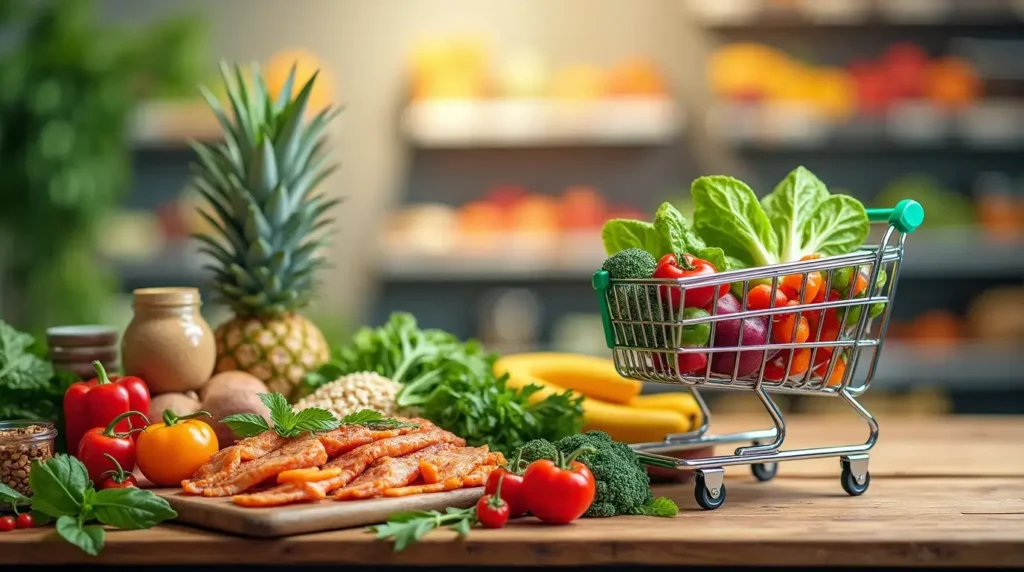
Table of Contents
Understanding Menopause and Its Impact on Weight Loss
Before we dive into the specifics of the menopause diet, it’s crucial to understand what’s happening to your body. Menopause is a natural phase in a woman’s life, typically occurring between the ages of 45 and 55, although it can happen earlier or later. This transition marks the end of your menstrual cycles and brings with it a significant shift in your hormone levels, particularly estrogen and progesterone.
These hormonal changes can lead to a number of physical changes, including weight gain. Here’s how it happens:
Why Does Weight Gain Occur During Menopause?
- Hormonal Shifts:
The decline in estrogen and progesterone levels can lead to an increase in belly fat. Estrogen, in particular, plays a role in fat distribution in the body. When its levels drop, fat tends to shift from the hips and thighs to the abdominal area. - Slower Metabolism:
With age and hormonal changes, your metabolism naturally slows down. This means that the same number of calories you ate a few years ago might now lead to weight gain, as your body doesn’t burn them off as efficiently. - Stress and Cortisol:
Menopause can be a stressful time, and increased levels of cortisol (the stress hormone) can encourage fat storage, especially around the abdominal area. - Loss of Muscle Mass:
As estrogen levels decline, so does muscle mass. Since muscle burns more calories than fat, this loss can make it even harder to keep off unwanted weight.
Understanding these changes can help you realize that losing weight during menopause isn’t about trying to fit into an old routine or diet. It requires a thoughtful approach that addresses your unique needs.
The Menopause Diet: 5-Day Plan to Lose Weight
Now that you have a clearer picture of what’s happening inside your body, let’s move on to your action plan—the 5-day menopause diet. This diet focuses on foods that support hormone balance, stabilize blood sugar, and improve metabolism, all while being easy to follow and effective.
Key Principles of the Menopause Diet
- Protein-Packed Meals: Protein helps to maintain muscle mass and boosts metabolism. Including lean proteins in each meal will keep you fuller for longer, reducing the temptation to snack.
- Healthy Fats: Healthy fats, such as those from avocados, olive oil, and fatty fish, are crucial for hormone production and overall health.
- Fiber-Rich Foods: Fiber aids in digestion and keeps you feeling full, helping to prevent overeating and sugar cravings. Aim for plenty of vegetables, legumes, and whole grains.
- Low Glycemic Index Foods: Stabilizing blood sugar is key to managing hunger and preventing fat storage. Opt for whole grains, berries, and other low-GI foods.
What You Can Expect in the First 5 Days
During these first five days, you’ll focus on fueling your body with nutrient-dense meals that stabilize hormones and jumpstart weight loss. By the end of the plan, many women notice reduced bloating, increased energy levels, and a stronger sense of control over their cravings. And while five days is just the beginning, it will set you on the right path for long-term success.
Day 1: Kickstarting Your Metabolism
Breakfast: Scrambled Eggs with Spinach and Avocado
Start your day with a nutrient-packed breakfast that includes protein, healthy fats, and fiber. Scrambled eggs are an excellent source of protein, while spinach and avocado provide vitamins, fiber, and healthy fats to support hormone balance.
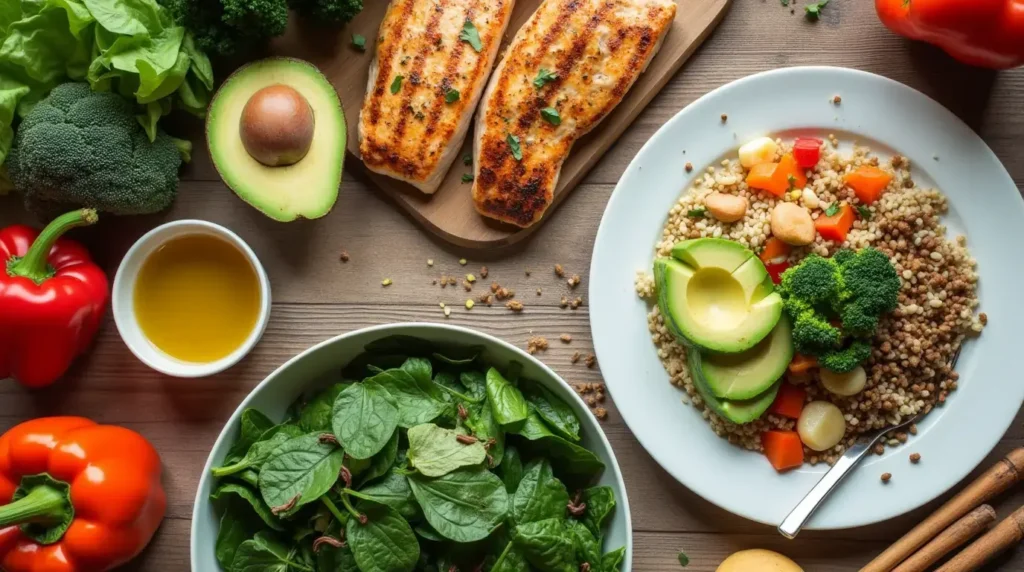
Lunch: Grilled Chicken Salad with Mixed Greens
For lunch, lean grilled chicken serves as a great source of protein, while mixed greens like kale, spinach, and arugula provide antioxidants and essential vitamins. Top it off with a light olive oil and lemon dressing for extra healthy fats.
Dinner: Baked Salmon with Steamed Broccoli and Quinoa
Dinner is a hearty, nutrient-rich meal. Salmon is high in omega-3 fatty acids, which help reduce inflammation and support heart health. Pair it with steamed broccoli (packed with fiber and antioxidants) and quinoa (a whole grain rich in protein).
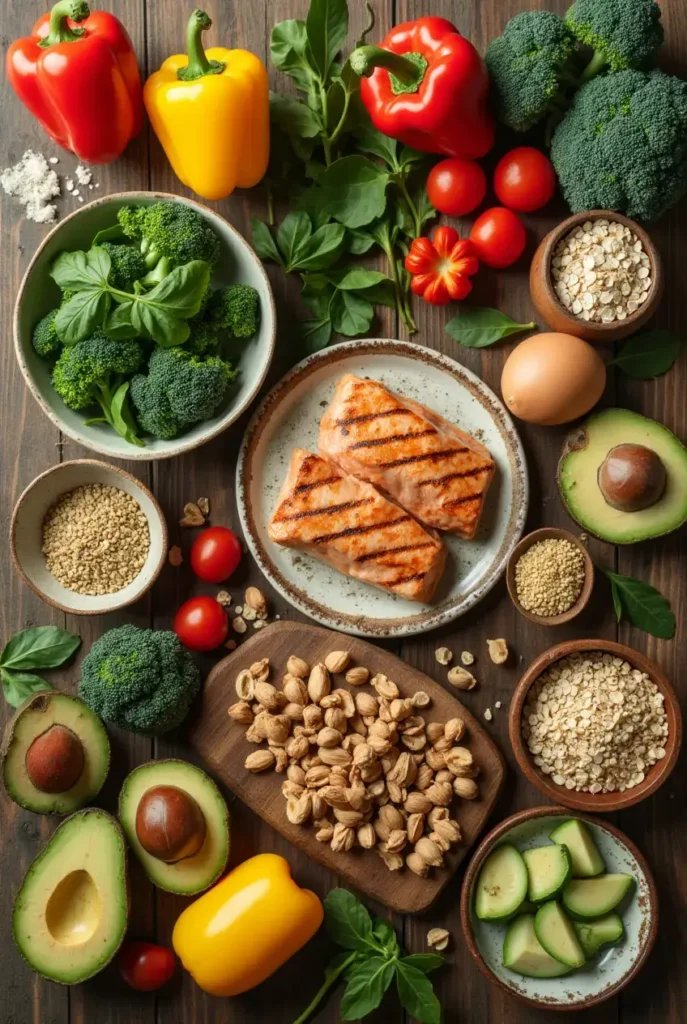
Snacks: Almonds or Greek Yogurt with Chia Seeds
Opt for a small handful of almonds or a serving of Greek yogurt with chia seeds for a satisfying snack that balances protein, fiber, and healthy fats.
Day 2: Focus on Detoxification and Gut Health
Breakfast: Chia Seed Pudding with Almond Milk and Berries
Chia seeds are loaded with fiber, which helps keep you feeling full and supports digestion. Pair them with antioxidant-rich berries and almond milk for a delicious and gut-friendly breakfast.
Lunch: Avocado and Turkey Lettuce Wraps
Instead of a traditional sandwich, go for lettuce wraps. Turkey provides lean protein, while avocado adds healthy fats and fiber, both important for hormone balance and digestion.
Dinner: Grilled Shrimp with Roasted Vegetables
Shrimp is low in calories but high in protein, making it a great choice for weight loss. Roasted vegetables such as zucchini, bell peppers, and carrots add fiber and essential nutrients to your dinner.
Snacks: Green Smoothie
A green smoothie with spinach, cucumber, apple, and protein powder will keep you hydrated while boosting your fiber intake.
Day 3: Hormone Balance and Increased Energy
Breakfast: Oatmeal with Ground Flaxseeds, Berries, and Cinnamon
Oats are a great source of soluble fiber, which helps regulate blood sugar levels. Adding flaxseeds, which are rich in omega-3 fatty acids, and cinnamon (known to balance blood sugar) makes this a powerhouse breakfast for menopause.
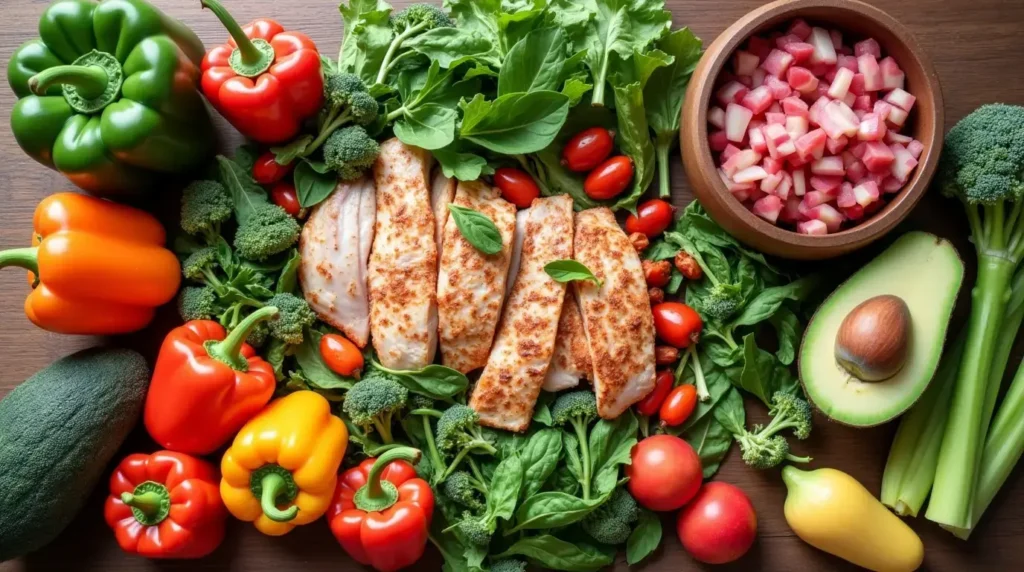
Lunch: Lentil Soup with Leafy Greens
Lentils are an excellent source of plant-based protein and fiber, while leafy greens like spinach provide additional nutrients to support hormone health.
Dinner: Turkey Meatballs with Zucchini Noodles and Roasted Sweet Potatoes
This dinner is rich in protein and low in carbs. Zucchini noodles are a great pasta alternative, while sweet potatoes provide healthy carbs and antioxidants to help reduce inflammation.
Snacks: Cucumber and Carrot Sticks with Hummus
For an afternoon snack, enjoy crunchy veggies with hummus. This combination provides fiber, healthy fats, and protein, helping to stave off hunger.
Day 4: Managing Stress and Improving Sleep
Breakfast: Scrambled Tofu with Sautéed Mushrooms and Tomatoes
Tofu is a plant-based protein that’s high in iron and calcium, essential nutrients for menopausal women. Paired with sautéed mushrooms and tomatoes, this meal is a great start to your day.
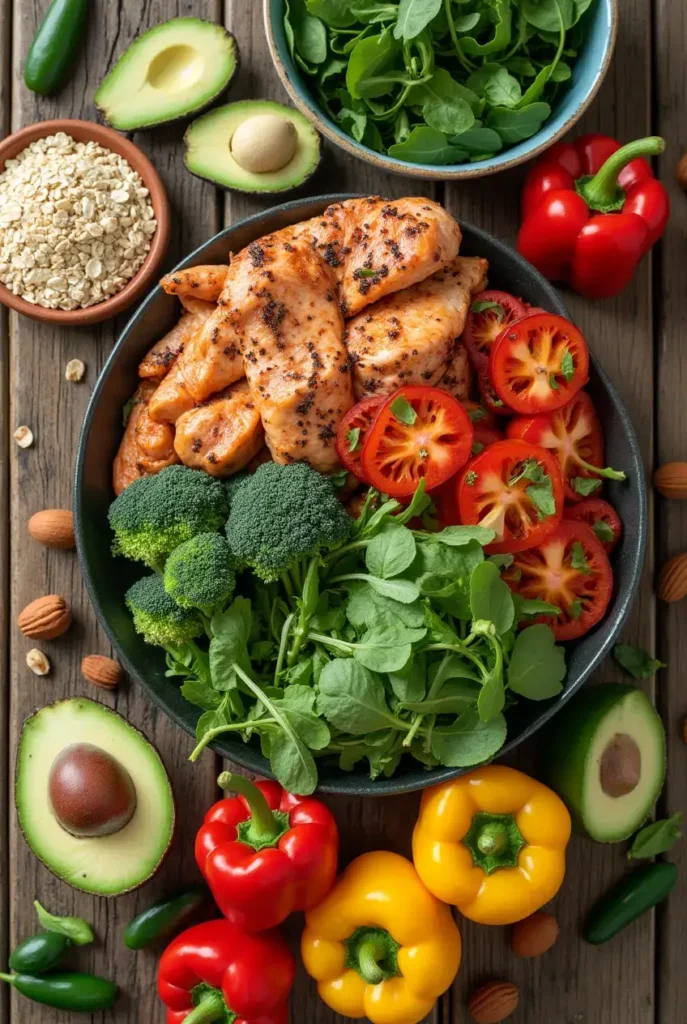
Lunch: Quinoa Salad with Chickpeas and Tahini Dressing
Quinoa is a complete protein and high in fiber, while chickpeas are packed with protein and iron. A tahini dressing adds healthy fats and a unique flavor to this filling salad.
Dinner: Grilled Chicken with Asparagus and Roasted Root Vegetables
Chicken is an excellent source of lean protein, while asparagus is rich in antioxidants and fiber. Roasted root vegetables like carrots and parsnips are high in vitamins A and C.
Snacks: Pumpkin Seeds or Dark Chocolate
Pumpkin seeds are high in magnesium, which helps reduce stress and promote better sleep. Dark chocolate is rich in antioxidants and can satisfy sweet cravings in moderation.
Day 5: Strengthening Your Immune System and Long-Term Sustainability
Breakfast: Greek Yogurt with Walnuts and Honey
Greek yogurt is packed with probiotics that promote gut health, while walnuts provide healthy fats. A drizzle of honey adds a touch of sweetness to this nutrient-dense breakfast.
Lunch: Salmon Salad with Kale and Avocado
A salmon salad provides plenty of omega-3 fatty acids, protein, and antioxidants, while kale is a nutrient-dense leafy green that supports detoxification.
Dinner: Stir-Fried Tofu with Vegetables and Brown Rice
This tofu stir-fry is rich in plant-based protein, and the brown rice provides complex carbohydrates for long-lasting energy. Vegetables like bell peppers and broccoli offer fiber and essential vitamins.
Snacks: Celery Sticks with Almond Butter
Celery is low in calories, while almond butter provides healthy fats and protein. This snack is perfect for managing hunger between meals.
Certainly! Below is a detailed SEO-optimized outline for an article titled “The Menopause Diet: 5-Day Plan to Lose Weight”. The structure is designed to be both reader-friendly and optimized for search engines, ensuring clarity, emotional resonance, and useful content.
The Menopause Diet: 5-Day Plan to Lose Weight
Opening: Connecting Personally with the Reader
- Introduction:
- Address the challenges of menopause: weight gain, hormonal changes, and difficulty losing weight.
- Acknowledge the reader’s frustration, offering empathy and understanding.
- Highlight that this article will provide a practical solution: a 5-day meal plan to kickstart weight loss during menopause.
Understanding Menopause and Its Impact on Weight Loss
- Key Points:
- What is Menopause?
- Brief explanation of menopause and perimenopause.
- Hormonal fluctuations (estrogen, progesterone) and their effects on metabolism and fat storage.
- The Menopause Weight Gain Struggle:
- How hormonal changes, slower metabolism, and increased stress can lead to weight gain.
- Impact of emotional factors (stress, sleep disturbances) on weight.
- Why Traditional Diets Don’t Work for Menopausal Women:
- How calorie restriction without understanding the hormonal impact can backfire.
- Importance of focusing on nutrient-dense foods and stabilizing blood sugar levels.
- Sources/Data to Include:
- Reference studies on menopause and weight gain (e.g., National Institute on Aging, Mayo Clinic).
- Mention of how the body’s needs change during menopause.
- What is Menopause?
H2: The Menopause Diet 5-Day Plan Overview
- Key Points:
- The Importance of a Structured Plan:
- Why having a set meal plan helps to reset metabolism and hormones.
- Focus on anti-inflammatory, nutrient-dense foods that promote fat loss and overall well-being.
- Key Principles of The Menopause Diet:
- Balancing macronutrients (protein, healthy fats, complex carbs).
- Hormone-balancing foods (e.g., flaxseeds, leafy greens, lean proteins).
- Fiber-rich foods for gut health and satiety.
- What You Can Expect in the First 5 Days:
- Gradual reduction in bloating, increased energy levels, and stabilized mood.
- A jumpstart in weight loss by focusing on nutrient-dense meals that support hormone balance.
- The Importance of a Structured Plan:
Day 1: Kickstarting Your Metabolism
- Key Points:
- Breakfast: Scrambled eggs with spinach and avocado.
- High protein, healthy fats, and fiber to keep you full and stabilize blood sugar.
- Lunch: Grilled chicken salad with mixed greens, olive oil, and lemon dressing.
- Dinner: Baked salmon with steamed broccoli and quinoa.
- Snacks: A handful of almonds or Greek yogurt with chia seeds.
- Key Takeaways:
- Focus on high-protein, low-carb meals to keep energy stable throughout the day.
- A great start to balance hormones and support fat-burning metabolism.
- Breakfast: Scrambled eggs with spinach and avocado.
Day 2: Focus on Detoxification and Gut Health
- Key Points:
- Breakfast: Chia seed pudding with almond milk and berries.
- Lunch: Avocado and turkey lettuce wraps.
- Dinner: Grilled shrimp with roasted vegetables and a side of quinoa.
- Snacks: A green smoothie (spinach, cucumber, apple, protein powder).
- Key Takeaways:
- Emphasize gut health and detoxification with fiber-rich and anti-inflammatory foods.
- Hydration is crucial—drink plenty of water throughout the day.
Day 3: Hormone Balance and Increased Energy
- Key Points:
- Breakfast: Oatmeal with ground flaxseeds, berries, and a dash of cinnamon.
- Lunch: Lentil soup with leafy greens and a side of mixed nuts.
- Dinner: Turkey meatballs with zucchini noodles and a side of roasted sweet potatoes.
- Snacks: Cucumber and carrot sticks with hummus.
- Key Takeaways:
- Focus on foods rich in omega-3 fatty acids, fiber, and protein to support hormone production.
- Eating nutrient-dense foods throughout the day keeps energy levels stable.
Day 4: Managing Stress and Improving Sleep
- Key Points:
- Breakfast: Scrambled tofu with sautéed mushrooms and tomatoes.
- Lunch: Quinoa salad with chickpeas, cucumber, and tahini dressing.
- Dinner: Grilled chicken with asparagus and roasted root vegetables.
- Snacks: A handful of pumpkin seeds or a small piece of dark chocolate.
- Key Takeaways:
- Focus on magnesium-rich foods to reduce stress and improve sleep quality.
- Maintain a balanced intake of fats, proteins, and carbohydrates to keep cortisol levels stable.
Day 5: Strengthening Your Immune System and Long-Term Sustainability
- Key Points:
- Breakfast: Greek yogurt with walnuts and a drizzle of honey.
- Lunch: Salmon salad with kale, olive oil, and avocado.
- Dinner: Stir-fried tofu with vegetables and brown rice.
- Snacks: Celery sticks with almond butter.
- Key Takeaways:
- Reinforce the importance of long-term habits and a balanced diet.
- Make sustainable food choices for overall health, weight loss, and well-being.
Menopause Diet: Key Nutrients to Include
- Key Points:
- Essential Nutrients for Weight Loss and Hormone Balance:
- Protein: Essential for maintaining muscle mass and metabolic rate.
- Healthy Fats: Supports hormone production and overall health (e.g., avocado, olive oil, flaxseeds).
- Fiber: Keeps you full, regulates blood sugar, and supports digestion.
- Magnesium: Helps reduce stress and promotes better sleep.
- Foods to Include in Your Diet:
- Leafy greens, berries, lean meats, nuts, seeds, fish, quinoa, legumes.
- Essential Nutrients for Weight Loss and Hormone Balance:
Menopause Diet FAQs
- What are the best foods for weight loss during menopause?
- Foods high in protein (lean meats, tofu, eggs), healthy fats (avocado, nuts), and fiber (vegetables, legumes) are essential for weight loss during menopause.
- How can I manage cravings during menopause?
- Focus on balancing blood sugar levels with high-fiber and high-protein meals to prevent sugar cravings.
- Can I exercise while following the 5-day plan?
- Yes! Combining the diet with light exercises such as walking, yoga, or strength training can enhance results.
Conclusion: Your Path to Weight Loss During Menopause
- Key Points:
- Summarize the importance of a balanced approach to weight loss during menopause.
- Encourage consistency and emphasize that a sustainable diet is the key to long-term results.
- Reaffirm that the 5-day plan is a great starting point, but healthy habits and self-care will lead to lasting success.
Table: Menopause Diet 5-Day Meal Plan Overview
| Day | Breakfast | Lunch | Dinner | Snacks |
|---|---|---|---|---|
| Day 1 | Scrambled eggs with spinach & avocado | Grilled chicken salad with mixed greens | Baked salmon with broccoli and quinoa | Almonds, Greek yogurt with chia |
| Day 2 | Chia seed pudding with berries | Turkey lettuce wraps with avocado | Grilled shrimp with roasted vegetables | Green smoothie |
| Day 3 | Oatmeal with flaxseeds and berries | Lentil soup with leafy greens | Turkey meatballs with zucchini noodles | Cucumber & carrot sticks with hummus |
| Day 4 | Scrambled tofu with mushrooms | Quinoa salad with chickpeas | Grilled chicken with asparagus | Pumpkin seeds, dark chocolate |
| Day 5 | Greek yogurt with walnuts and honey | Salmon salad with kale and avocado | Stir-fried tofu with vegetables and rice | Celery sticks with almond butter |
Menopause Diet: Key Nutrients to Include
To truly succeed in your weight loss journey during menopause, it’s important to include key nutrients in your diet:
- Protein:
Protein helps preserve lean muscle mass, boosts metabolism, and keeps you full. Include lean meats, tofu, legumes, and fish in your meals. - Healthy Fats:
Healthy fats like those found in avocados, olive oil, and fatty fish are essential for hormone production and overall health. - Fiber:
Fiber aids digestion, stabilizes blood sugar levels, and keeps you feeling full for longer periods. Focus on vegetables, whole grains, and legumes. - Magnesium:
Magnesium is crucial for reducing stress and improving sleep quality. Include foods like leafy greens, seeds, and nuts.
Menopause Diet FAQs
What are the best foods for weight loss during menopause?
The best foods include lean proteins (chicken, fish, tofu), healthy fats (avocado, nuts), and fiber-rich vegetables, fruits, and whole grains.
How can I manage cravings during menopause?
Balancing blood sugar by eating protein-rich and high-fiber meals can help prevent cravings. Also, magnesium-rich foods can reduce stress and sugar cravings.
Can I exercise while following the 5-day plan?
Absolutely! Regular exercise, like walking, yoga, or strength training, will complement your diet and accelerate weight loss during menopause.
Conclusion: Your Path to Weight Loss During Menopause
You’ve learned that weight loss during menopause isn’t about starving yourself or following extreme diets. It’s about fueling your body with hormone-balancing foods, managing stress, and maintaining a sustainable lifestyle. This 5-day meal plan is a great start, but the key to lasting success lies in building long-term, healthy habits.
Ready to start? Begin today with this simple plan and feel the positive changes in your body and mind. You deserve to feel confident, energized, and at peace with your body, no matter what stage of life you’re in.
For further details on this diet plan and its benefits during menopause, you can refer to the following resources:
If you’re looking for a quick and healthy way to incorporate more protein into your menopause diet, consider adding salmon to your meals. It’s a great source of omega-3 fatty acids and lean protein, both of which support hormone balance and weight loss. Not sure how to cook it? Try using an air fryer for a fast, easy, and flavorful option. For step-by-step instructions on how to cook perfect frozen salmon in an air fryer, check out our simple guide for tips and tricks that will make cooking salmon a breeze.







